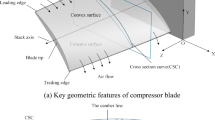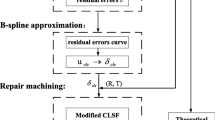Abstract
Repair of damaged blade in aero-engine reduces economic losses and has been applied widely in factory areas. However, the actual blade model after service is not consistent with the theoretical model. Thus, the reconstructed blade model is required. Different damage areas, damage forms and operations in the additive process may lead to different deformations of the blades, thus the actual CAD model of the blade is also different, resulting in the challenge when reconstruct the model. In this paper, a new model reconstruction method of blade-repair is proposed based on the linear combination of base curves blending algorithm. Firstly, the blade after additive processing is measured and such data is processed and registered with the theoretical model. Secondly, the area created by measurement data is smoothly blended to the theoretical area utilizing a developed linear combination algorithm, leading to the capability of providing the reconstructed concave and convex surfaces. Finally, the reconstructed concave and convex surfaces are bridged to theoretical leading and trailing edges. Consequently, the intact reconstructed model of the damaged blade is obtained. The blade-repair case study demonstrates the availability of the proposed method and the analysis of machining error indicates that the blending between the reserved area and the theoretical area of the reconstructed model is smooth.
















Similar content being viewed by others
References
Zhang, Y., Zhang, D., Wu, B. A geometry reconstruction approach based on cross-section curve blending for adaptive repair of blades. In: 5th International conference on responsive manufacturing-green manufacturing (ICRM 2010), 11–13 Jan. 2010 2010 (pp. 146–151). doi:https://doi.org/10.1049/cp.2010.0428.
Piya, C., Wilson, J. M., Murugappan, S., Shin, Y., & Ramani, K. (2011). Virtual repair: Geometric reconstruction for remanufacturing gas turbine blades. In ASME 2011 International design engineering technical conferences and computers and information in engineering conference (Vol. 9, pp. 895–904). https://doi.org/10.1115/DETC2011-48652.
Wilson, J. M., Piya, C., Shin, Y. C., Zhao, F., & Ramani, K. (2014). Remanufacturing of turbine blades by laser direct deposition with its energy and environmental impact analysis. Journal of Cleaner Production, 80, 170–178. https://doi.org/10.1016/j.jclepro.2014.05.084.
Rong, Y., Xu, J., & Sun, Y. (2013). A surface reconstruction strategy based on deformable template for repairing damaged turbine blades Proceedings of the Institution of Mechanical Engineers, Part G. Journal of Aerospace Engineering, 228(12), 2358–2370. https://doi.org/10.1177/0954410013517091.
Tao, W., Ding, H. P., Hao, W., & Jie, T. (2015). Virtual remanufacturing: Cross-section curve reconstruction for repairing a tip-defective blade Proceedings of the Institution of Mechanical Engineers Part C. Journal of Mechanical Engineering Science, 229(17), 3141–3152. https://doi.org/10.1177/0954406214567135.
Zhao, Z., Fu, Y., Liu, X., Xu, J., Wang, J., & Mao, S. (2017). Measurement-based geometric reconstruction for milling turbine blade using free-form deformation. Measurement, 101, 19–27. https://doi.org/10.1016/j.measurement.2017.01.009.
Yu, H., & Lyu, X. (2017). Repair of defective 3D blade model based on deformation of adjacent non-defective cross-sectional curve. The International Journal of Advanced Manufacturing Technology, 95(5–8), 3045–3055. https://doi.org/10.1007/s00170-017-1393-8.
Hou, F., Wan, N., Chang, Z., Chen, Z., & Sun, H. (2017). An adaptive repair surface modeling approach for worn blades. The International Journal of Advanced Manufacturing Technology, 94(1–4), 523–532. https://doi.org/10.1007/s00170-017-0859-z.
Gao, J., Wen, H., Lin, Z., Wu, H., Li, S., Chen, X., et al. (2017). Geometric model reconstruction through a surface extension algorithm for remanufacturing of twist blades. Rapid Prototyping Journal, 23(2), 382–390. https://doi.org/10.1108/rpj-11-2015-0179.
Yilmaz, O., Gindy, N., & Gao, J. (2010). A repair and overhaul methodology for aeroengine components. Robotics and Computer-Integrated Manufacturing, 26(2), 190–201. https://doi.org/10.1016/j.rcim.2009.07.001.
He, J., Li, L., and Li, J. Research of Key-Technique on Automatic Repair System of Plane Blade Welding. In: 2011 International Conference on Control, Automation and Systems Engineering (CASE), 30–31 July 2011 2011 (pp. 1–4). doi:https://doi.org/10.1109/ICCASE.2011.5997615.
Lin, X., Chen, Y., Wang, Z., Guo, Y., Gao, Y., & Zhang, X. J. A. A. E. A. S. (2015). Model restructuring about leading edge and tailing edge of precision forging blade for adaptive machining. Hangkong/Acta Aeronautica et Astronautica Sinica, 36(5), 1695–1703.
Zhang, X., Li, W., & Liou, F. (2017). Damage detection and reconstruction algorithm in repairing compressor blade by direct metal deposition. The International Journal of Advanced Manufacturing Technology, 95(5–8), 2393–2404. https://doi.org/10.1007/s00170-017-1413-8.
Li, J., Yao, F., Liu, Y., and Wu, Y. (2010). Reconstruction of Broken Blade Geometry Model Based on Reverse Engineering. Paper presented at the 2010 Third International Conference on Intelligent Networks and Intelligent Systems.
Jones, J., McNutt, P., Tosi, R., Perry, C., & Wimpenny, D. (2012). Remanufacture of turbine blades by laser cladding, machining and in-process scanning in a single machine. In 23rd Annual International Solid Freeform Fabrication Symposium, 2012 (pp. 821–827). Austin, TX, USA: University of Texas. http://hdl.handle.net/2086/7552.
Wang, T., Liu, Y., Wang, L. W., Wang, H., & Tang, J. (2011). Digitally reverse modeling for the repair of blades in aero-engines. Applied mechanics and materials., 141, 258–263.
Wang, H., Jun Cai, Z., & Wang, L. W. (2012). 3D model reconstruction of the broken aeroengine blade based on multi-scale genetic algorithm. Advanced Materials Research., 479–481, 2250–2254.
Zhang, Y., Yang, Z., He, G., Qin, Y., & Zhang, H.-C. (2015). Remanufacturing-oriented geometric modelling for the damaged region of components. Procedia CIRP, 29, 798–803. https://doi.org/10.1016/j.procir.2015.02.164.
Sun, B., & Li, B. (2016). Laser displacement sensor in the application of aero-engine blade measurement. IEEE Sensors Journal, 16(5), 1377–1384. https://doi.org/10.1109/jsen.2015.2497363.
Li, W., Zhou, L., & Yan, S. (2014). A case study of blade inspection based on optical scanning method. International Journal of Production Research, 53(7), 2165–2178. https://doi.org/10.1080/00207543.2014.974851.
Shi, Z., Li, X., Li, Y., & Lin, J. (2019). A high-precision form-free metrological method of aeroengine blades. International Journal of Precision Engineering and Manufacturing, 20, 2061–2076. https://doi.org/10.1007/s12541-019-00227-5.
Wang, H., Huang, L., Yao, C., Kou, M., Wang, W., Huang, B., & Zheng, W. (2015). Integrated analysis method of thin-walled turbine blade precise machining. International Journal of Precision Engineering and Manufacturing, 16(5), 1011–1019. https://doi.org/10.1007/s12541-015-0131-0.
Hartmann, E. (2001). Parametric gnblending of curves and surfaces. The Visual Computer, 17(1), 1–13. https://doi.org/10.1007/PL00013398.
Boehm, W. (1980). Inserting new knots into B-Spline curves. Computer-Aided Design, 12(4), 199–201. https://doi.org/10.1016/0010-4485(80)90154-2.
Acknowledgements
The authors gratefully acknowledge the financial support of the National Science and Technology Major Project (Grant No. 2017ZX04011013), Shaanxi Key Research and Development Program in Industrial Domain (Grant No.2018ZDXM-GY-063), the Fundamental Research Funds for the Central Universities (Grant No.31020200504003).
Author information
Authors and Affiliations
Corresponding author
Additional information
Publisher's Note
Springer Nature remains neutral with regard to jurisdictional claims in published maps and institutional affiliations.
Rights and permissions
About this article
Cite this article
Wu, B., Zheng, H., Zhang, Y. et al. A Model Reconstruction Method of Blade Repair Based on Linear Combination. Int. J. Precis. Eng. Manuf. 22, 383–394 (2021). https://doi.org/10.1007/s12541-020-00449-y
Received:
Revised:
Accepted:
Published:
Issue Date:
DOI: https://doi.org/10.1007/s12541-020-00449-y




